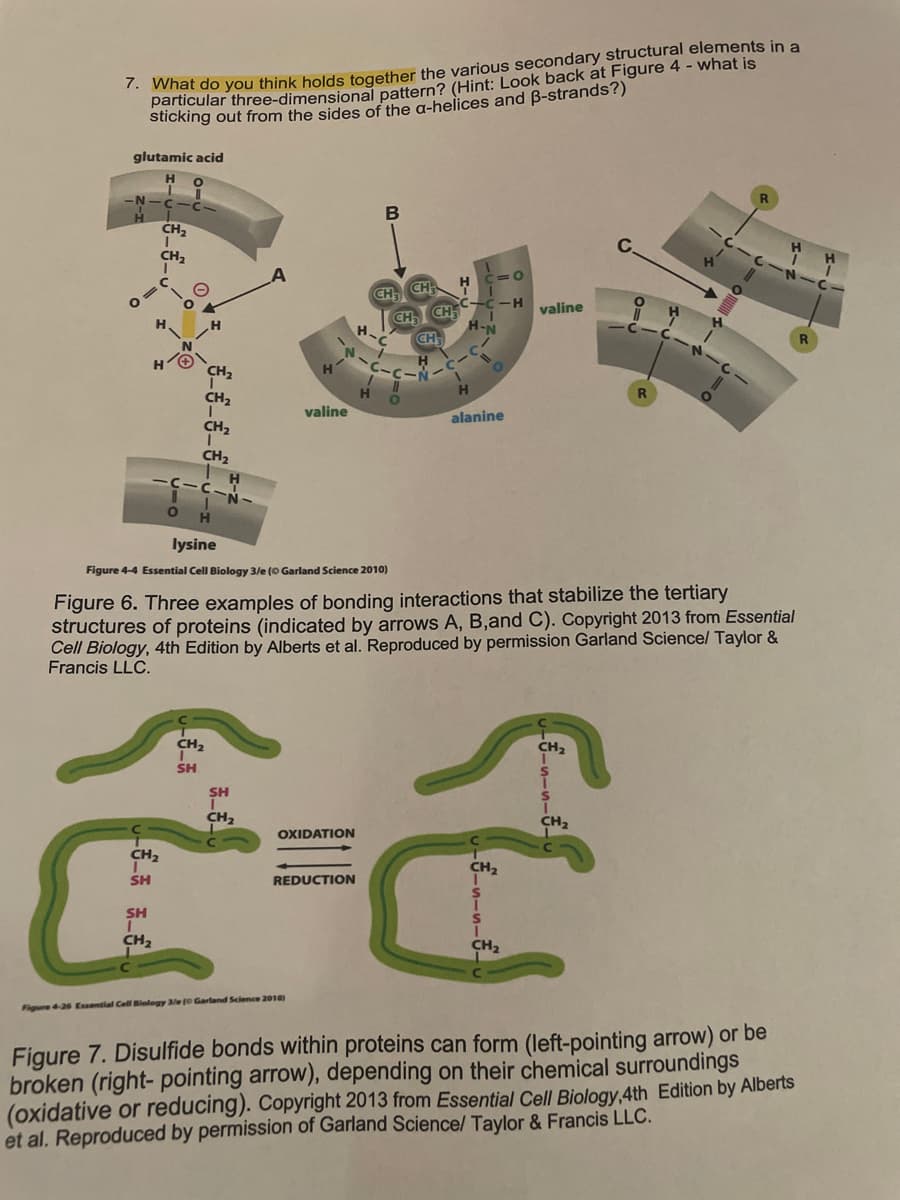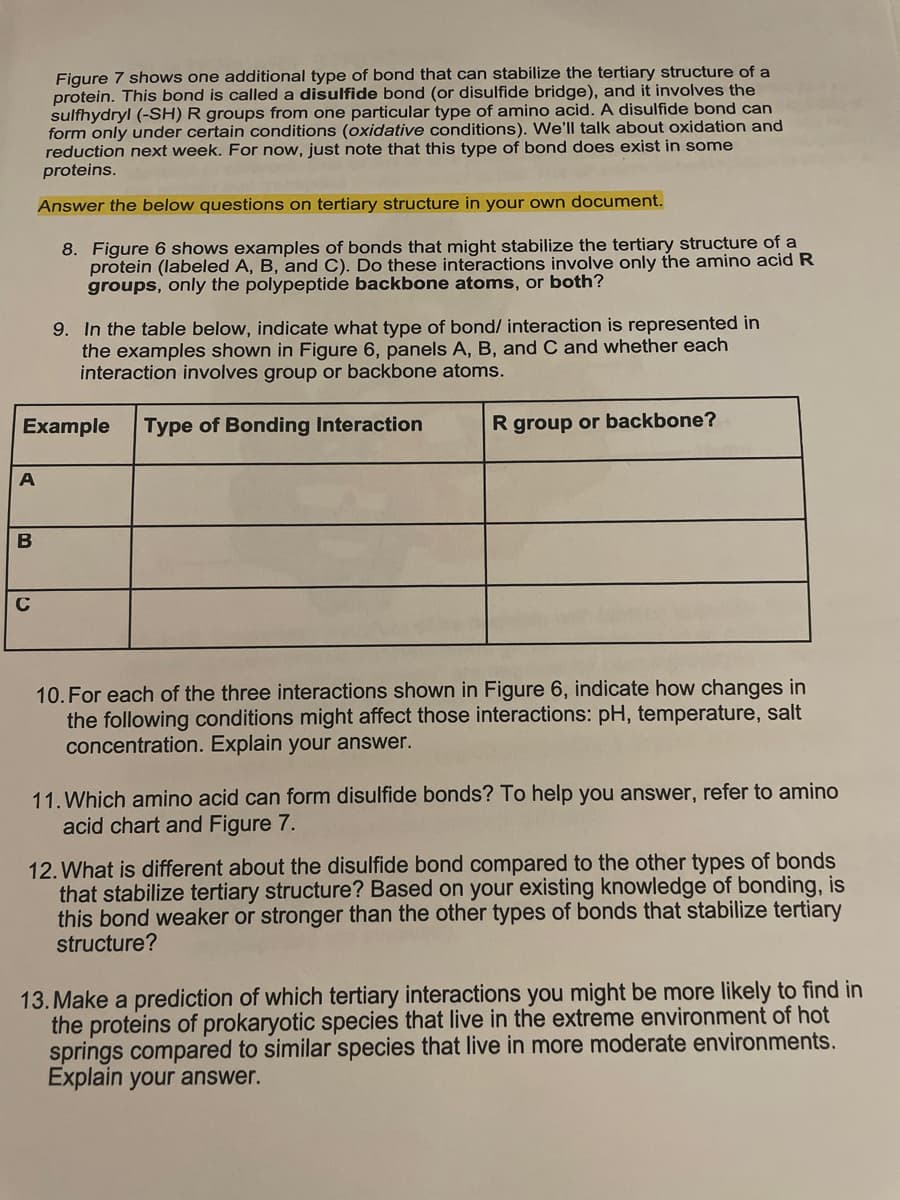. Vwhat do you think holds together the various secondary structural elements in a Stickular three-dimensional pattern? (Hint: Look back at Figure 4 - what is Sticking out from the sides of the a-helices and B-strands?) glutamic acid H N-C-C -C-Cーや CH2 C. CH2 H C=0 CH CH C-C-H valine CHI CH H-N CH H
. Vwhat do you think holds together the various secondary structural elements in a Stickular three-dimensional pattern? (Hint: Look back at Figure 4 - what is Sticking out from the sides of the a-helices and B-strands?) glutamic acid H N-C-C -C-Cーや CH2 C. CH2 H C=0 CH CH C-C-H valine CHI CH H-N CH H
Biology 2e
2nd Edition
ISBN:9781947172517
Author:Matthew Douglas, Jung Choi, Mary Ann Clark
Publisher:Matthew Douglas, Jung Choi, Mary Ann Clark
Chapter16: Gene Expression
Section: Chapter Questions
Problem 3VCQ: Figure 16.13 An increase in phosphorylation levels of elF-2 has been observed in patients with...
Related questions
Question

Transcribed Image Text:* hat do you think holds together the various secondary structural elements in a
Particular three-dimensional pattern? (Hint: Look back at Figure 4 - what is
sticking out from the sides of the a-helices and B-strands?)
glutamic acid
B
CH,
CH
valine
CH
H-N
CH
H.
valine
alanine
CH2
CH2
lysine
Figure 4-4 Essential Cell Biology 3/e (O Garland Science 2010)
Figure 6. Three examples of bonding interactions that stabilize the tertiary
structures of proteins (indicated by arrows A, B,and C). Copyright 2013 from Essential
Cell Biology, 4th Edition by Alberts et al. Reproduced by permission Garland Science/ Taylor &
Francis LLC.
CH2
CH,
SH
SH
CH2
CH2
OXIDATION
CH2
SH
REDUCTION
SH
CH2
CH2
Figure 4-26 Essential Cell Bialogy 3e o Garland Science 2010)
Figure 7. Disulfide bonds within proteins can form (left-pointing arrow) or be
broken (right- pointing arrow), depending on their chemical surroundings
(oxidative or reducing). Copyright 2013 from Essential Cell Biology,4th Edition by Alberts
et al. Reproduced by permission of Garland Science/ Taylor & Francis LLC.

Transcribed Image Text:Figure 7 shows one additional type of bond that can stabilize the tertiary structure of a
protein. This bond is called a disulfide bond (or disulfide bridge), and it involves the
sulfhydryl (-SH) R groups from one particular type of amino acid. A disulfide bond can
form only under certain conditions (oxidative conditions). We'll talk about oxidation and
reduction next week. For now, just note that this type of bond does exist in some
proteins.
Answer the below questions on tertiary structure in your own document.
8. Figure 6 shows examples of bonds that might stabilize the tertiary structure of a
protein (labeled A, B, and C). Do these interactions involve only the amino acid R
groups, only the polypeptide backbone atoms, or both?
9. In the table below, indicate what type of bond/ interaction is represented in
the examples shown in Figure 6, panels A, B, and C and whether each
interaction involves group or backbone atoms.
Example
Type of Bonding Interaction
R group or backbone?
B
C
10. For each of the three interactions shown in Figure 6, indicate how changes in
the following conditions might affect those interactions: pH, temperature, salt
concentration. Explain your answer.
11. Which amino acid can form disulfide bonds? To help you answer, refer to amino
acid chart and Figure 7.
12. What is different about the disulfide bond compared to the other types of bonds
that stabilize tertiary structure? Based on your existing knowledge of bonding, is
this bond weaker or stronger than the other types of bonds that stabilize tertiary
structure?
13. Make a prediction of which tertiary interactions you might be more likely to find in
the proteins of prokaryotic species that live in the extreme environment of hot
springs compared to similar species that live in more moderate environments.
Explain your answer.
Expert Solution
This question has been solved!
Explore an expertly crafted, step-by-step solution for a thorough understanding of key concepts.
This is a popular solution!
Trending now
This is a popular solution!
Step by step
Solved in 2 steps

Recommended textbooks for you

Biology 2e
Biology
ISBN:
9781947172517
Author:
Matthew Douglas, Jung Choi, Mary Ann Clark
Publisher:
OpenStax

Biology (MindTap Course List)
Biology
ISBN:
9781337392938
Author:
Eldra Solomon, Charles Martin, Diana W. Martin, Linda R. Berg
Publisher:
Cengage Learning

Biology 2e
Biology
ISBN:
9781947172517
Author:
Matthew Douglas, Jung Choi, Mary Ann Clark
Publisher:
OpenStax

Biology (MindTap Course List)
Biology
ISBN:
9781337392938
Author:
Eldra Solomon, Charles Martin, Diana W. Martin, Linda R. Berg
Publisher:
Cengage Learning